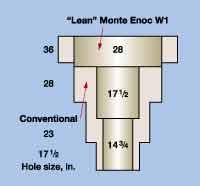Lean Profile drilling at Val d'Agri
April 2000 Vol. 221 No. 4 Feature Article Lean Profile drilling at Val d’Agri A. Calderoni, A. Ligrone and C. Molashi, Eni-Agip Division In the pap
Lean Profile drilling at Val d’AgriA. Calderoni, A. Ligrone and C. Molashi, Eni-Agip Division In the paper SPE/IADC 52788, "The Lean Profile: A step change in drilling performance," presented by the authors at the 1999 SPE/IADC Drilling Conference, Amsterdam, March 9 – 11, 1999, an innovative drilling technique which aims at maintaining 1-in. clearance throughout the whole casing program, leading to a slimmer well profile but keeping the same size for the production casing string, was described. To achieve this, it is mandatory to adopt suitable drilling technologies discussed in the paper. The following summary outlines some key points from the paper. The Lean Profile has been successfully applied to some wells drilled from onshore clusters with parallel vertical sections as long as 2,000 m. The drilling environment is challenging, with problems such as tendencies to deviate from the vertical trajectory, wellbore instability and circulation losses. In this scenario, the new method provided for dramatic time and cost reductions. The procedure is part of the drilling strategy for some 30 wells in Val d’Agri, southern Italy, with interesting cost saving opportunities.
The Lean Profile. "Lean" is a re-definition of the well profile based on a drastic reduction of clearance between casing OD and hole diameter. This leads to a "slimmer" casing profile which reduces drilling CAPEX. The figure shows a comparison between a lean and a conventional hole-size profile. The reduction of rock volume drilled impacts material consumption and drilling performance, as described below. The application is based on these requirements: absolute control of a vertical trajectory; and use of flush- or near-flush joint connections. The first condition is achievable using an automatic drilling system. The Straight-hole Drilling Device (SDD) provides control of vertical direction and, therefore, gives the best environment for running casing in a reduced clearance. Main advantages of the lean approach include the following highlighted items. Better drilling performance is a direct consequence of the smaller volumes of rock drilled. Experience shows that it is possible to reduce drilling time by about 40%. Less material consumption – a slimmer profile requires less material for casings, drilling fluids, cement and additives. Lower environmental impact – fewer drilling fluids used means less waste disposal. Improved cementing is a consequence of the smaller holes. Hole-enlargement problems are less frequent; and reduced clearance provides better hydraulics for slurry displacement. Reduced risk of stuck pipe – drilling in a straight, vertical hole with a BHA comprising just one or two reamers reduces risk of stuck pipe due to the hole geometry. Also, in the event of hole collapse, there will be a lower probability of cuttings / cavings forming. Reduced risk of drillstring failures is a consequence of no pipe rotation for steering control. Improved safety – use of the SDD, which operates in sliding mode, practically eliminates casing wear. Also, having a lean, straight, vertical well provides a better environment for well control. Special considerations for these critical technologies are detailed in the referenced paper. Field experience. The first applications were on some developments in the Val d’Agri, Basilicata region, in southern Italy. In the Monte Enoc 9 well, a conventional program would feature 32, 24-1/2, 18-5/8, 14 and 9-7/8-in. casing above a 7-in. liner. The lean profile adopted was 24-1/2, 18-5/8, 16, 13-3/8 and 9-7/8-in. strings. The 16 in. was run in a 17-1/2-in. hole, vs. conventional 18-5/8-in. in a 23-in. hole. Hole size for the 13-3/8 in. was 14-3/4 in. The profile used, as above, had the same number of casing strings as the conventional profile. But solution of formation-instability problems allowed one intermediate string to be eliminated from the Monte Enoc W1 well. The trend is clearly positive – elimination of a casing string led to an average drilling-time reduction of about 40%. This is a sign of the step change in drilling performance. Cost considerations. Drill time saved at Monte Enoc W1 was 53 days, a time compression of some 40%, resulting in a cost savings of $1,699,500. Total savings for less materials consumption and waste disposal is estimated at $583,000, and cost for the SDD is estimated to be $648,000. Therefore, economic impact on drilling CAPEX for this well is a net savings of $1,634,500. From this analysis, it appears that the additional cost, i.e., the SDD, is nearly paid for by savings from less material consumption and waste disposal; and drill time and daily fixed costs are the variables that affect economics the most. This technique is now part of a drilling strategy for Val d’Agri. To date
(early 1999), application of the method was limited to vertical holes, restricting application to vertical
onshore wells and offshore exploration wells. However, rotary steerable systems generate some optimism about
extending the technique to other operating environments, e.g., deep water is an environment where the
technique may provide substantial advantages. |



